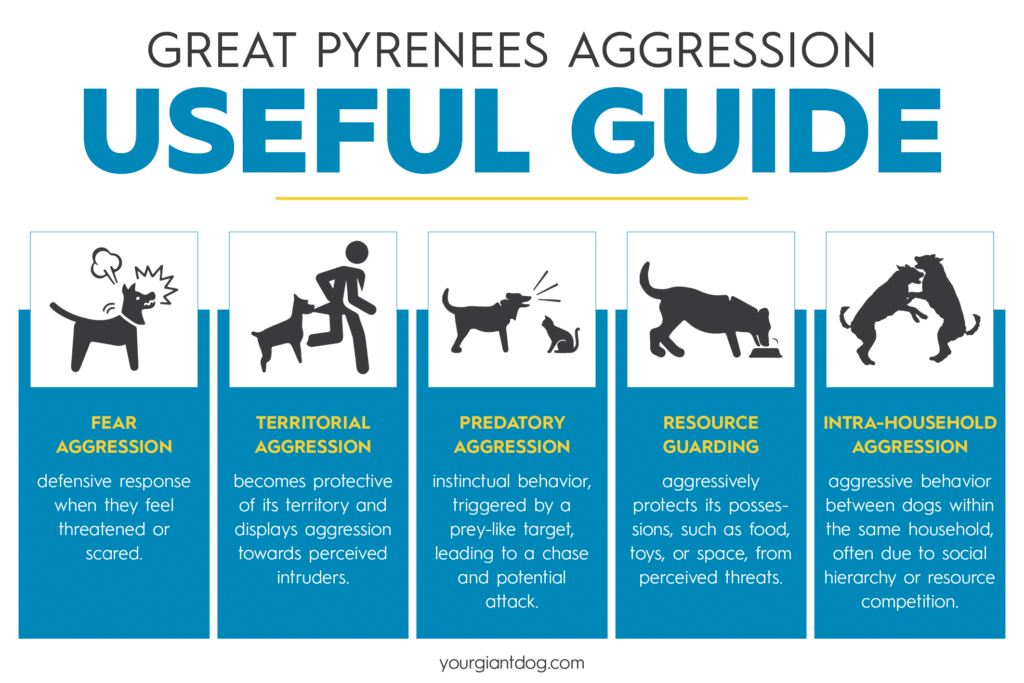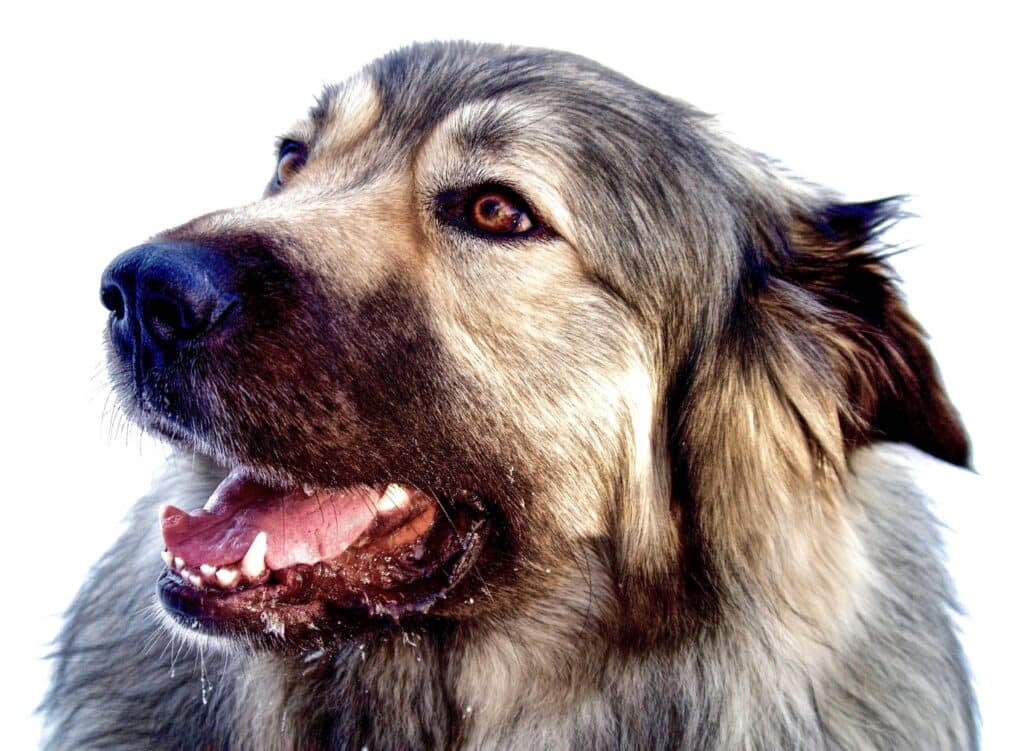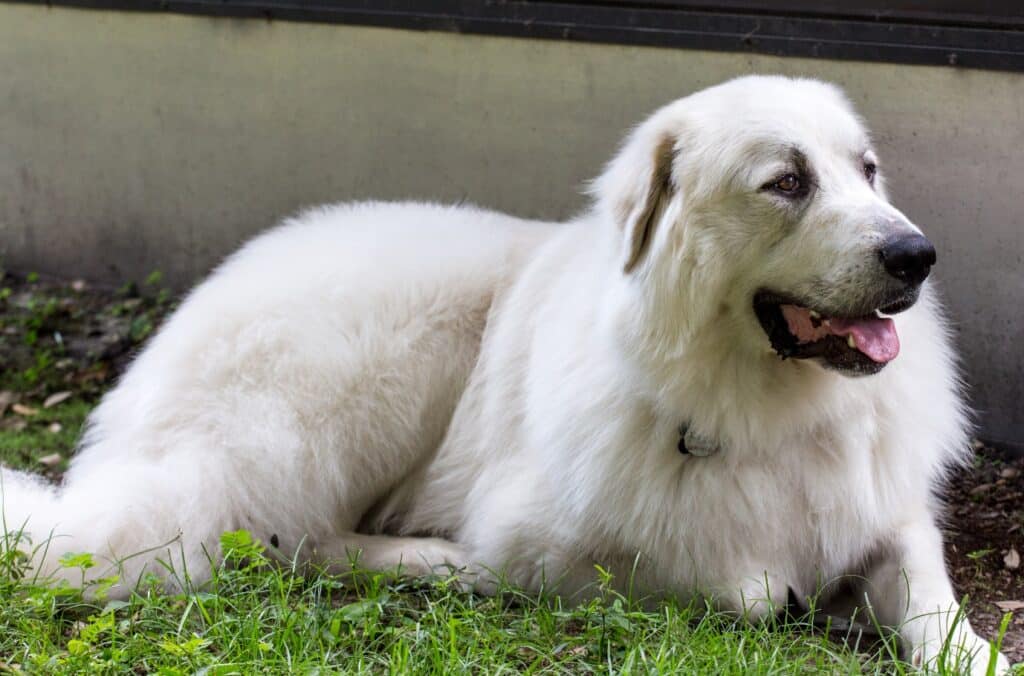Have you had a Great Pyrenees growl at you, even when you’ve done nothing to deserve it? If so, you’re probably wondering why.
Here’s a look at some possible reasons why your dog might be growling at you, as well as some tips to help manage the behavior.
Main Reasons my Great Pyrenees will Growl at Me.
Many dog owners are perplexed when their dog growls at them. After all, they provide food, shelter, and love to their furry friend.
However, there are several reasons why your Great Pyrenees may growl at you.
Suffering Pain
If your Great Pyrenees is growling at you, it may be suffering from pain.
This is especially true if the growling is accompanied by other signs of discomfort, such as licking or chewing at a particular spot on their body, whining, or decreased activity levels.
“If you think your dog may be in pain, take them to the vet for an evaluation. The sooner you can get them relief, the better”.
Anxious or Stressed
Your Great Pyrenees may growl at you because it is anxious or stressed. It’s important to understand the difference between the two, so you can help your dog feel better. Anxiety is a feeling of worry, nervousness, or unease.
Stress is a response to a demand or pressure. Dogs can experience both anxiety and stress. For example, your dog may feel anxious or stressed because it is in a new environment, around new people, or during fireworks.
If your Great Pyrenees is growling at you out of anxiety or stress, try to calm them down. This may be difficult if your dog is growling at you for no reason. In this case, it’s best to get help from a professional dog trainer or veterinarian.
Showing Affection
Most dog owners have experienced their pet showing affection in some way, whether it’s a lick on the face or a wagging tail.
But what about when your dog growls at you? It may seem strange, but this is actually one way that your Great Pyrenees may be showing their affection for you.
Growling is often misinterpreted as aggressive behavior, but in reality, it can be a sign of happiness or excitement. Dogs will sometimes make a soft “grrr” sound when they are playing with other dogs or when they want to initiate play.
This is similar to the way that your Great Pyrenees may growl at you when it wants to play or receive attention.
So, if your Great Pyrenees starts growling at you, don’t be alarmed.
Wanting to Play
Your Great Pyrenees may growl at you when it wants to play for a few reasons. First, your dog may be trying to get your attention so that you’ll play with it.
If you’ve been ignoring your dog or if it feels like you’re always busy, it may start to growl as a way to get your attention. Additionally, growling can be a sign of excitement and happiness in dogs.
So, if your dog is wagging its tail and looking at you with a big smile while it’s growling, it’s probably just trying to tell you that it wants to have some fun. Finally, some dogs may growl during play because they’re feeling rough and tumble.
If your dog starts getting too rowdy, make sure to provide guidance so that everyone stays safe and has a good time.
Being Territorial or Protective
According to The American Kennel Club, the Great Pyrenees is known to be “calm, gentle and affectionate”. They are also known to be great protectors of their families and home. So, it’s no surprise that your Great Pyrenees growls at you when they first meet you.
Don’t fret though, this doesn’t mean they don’t like you. In fact, it may just mean the opposite. When you see a Great Pyrenees growl at someone, it could be because they are being territorial or protective.
“If you find yourself on the receiving end of a Great Pyrenees growl, try not to take it personally. Instead, use it as an opportunity to get to know your new furry friend better and build a bond that will last a lifetime”.
Aggression
If you’ve had a Great Pyrenees growl at you, it could be a sign of aggression. It may be feeling threatened or defensive.
Often, dogs will growl when they are trying to protect something that they see as valuable, such as food or a toy. It’s important to remain calm and avoid making any sudden movements.
Try to determine what is causing the dog to feel threatened and remove the trigger if possible. If your dog continues to exhibit aggressive behavior, it’s best to consult with a professional trainer or behaviorist for help.

RECOMMENDED – The Ultimate Great Pyrenees Guide – All Questions Answered!
Should I be Worried if my Dog Growls at Me?

No, you shouldn’t be worried if your dog growls at you. Growling is a normal part of canine communication and usually doesn’t indicate aggression. If your dog growls while playing, it’s likely just part of the game.
However, if your dog growls when you try to take away its food or toys, this could be a sign of resource guarding, and you should seek professional help.
Also, if your dog growls at you, it can be a sign that they are feeling threatened or uncomfortable. If your dog is growling because they want something, such as food or attention, then you probably don’t need to worry.
However, if your dog is growling and showing other signs of aggression, such as baring its teeth or lunging at you, then you should seek professional help from a trainer or behaviorist.
With proper training and socialization, most dogs can learn to control their aggression and live peacefully with their family.
Will my Dog Bite if he Growls?
Although it may seem like your dog is growling at you out of aggression, there are actually a variety of reasons why your dog may be growling.
Before you assume that your dog is trying to bite you, it’s important to understand the context of the growl and your dog’s body language.
Growling is often used as a warning sign by dogs. If your dog is growling at you, he may be trying to tell you that he’s feeling uncomfortable or threatened.
For example, if you approach your dog while he’s sleeping and he starts to growl, he may be feeling defensive and scared.
Sometimes, dogs will also growl when they’re playing. This is usually a sign that they’re enjoying themselves and not feeling any aggression toward the person they’re playing with.
Should I Yell at my Dog if he Growls?
There are a lot of different opinions out there about whether or not you should yell at your dog if he growls.
Some people think it’s a good way to show your dog who’s boss, while others think that it will make your dog more fearful and less likely to listen to you. So, what’s the right answer?
Well, it depends on the situation. If your dog is growling because he’s afraid or in pain, then yelling at him is only going to make things worse.
However, if your dog is growling because he’s being aggressive or territorial, then yelling may be the best way to get his attention and stop the behavior.
“Ultimately, you know your dog best and you’ll have to use your own judgment to decide whether or not yelling is the best option in any given situation”.
How Do You Respond When a Dog Growls at You?

When a dog growls at you, it is important to remain calm. Avoid making any sudden movements or loud noises, as this may startle the dog and cause them to become aggressive.
If the dog is not acting aggressively, you may try to pet them calmly. However, if the dog appears to be aggressive, it is best to back away slowly and leave the area.
In some cases, the dog may be uncomfortable with your presence and growl in order to get you to go away. If this is the case, it’s best to leave them alone and let them calm down.
If the dog is acting aggressively and lunging at you, it’s important to remain calm. You may try to avoid eye contact with the dog, but if they do not appear aggressive, you can calmly back away from the situation.
If you’re bitten, it’s important to remain calm. Try to stay as still and quiet as possible so that the dog does not feel threatened by your movement. Gently remove yourself from the situation and seek medical attention immediately.
Most dog owners are familiar with the sound of their dogs growling. For some, it’s a sign of affection. For others, it’s a sign of aggression. But what does it mean when your dog growls at you?
There are a number of reasons why your dog might be growling at you. It could be a sign of fear or anxiety, or it could be a warning that they don’t want to be disturbed.
If your dog is growling at you, it’s important to try to understand why they’re doing it so you can respond in the best way possible.
“One reason why your dog might be growling at you is if they’re not properly socialized. If your dog isn’t used to being around people, they may be feeling scared or threatened when you approach them”.
This may be especially true if your pup is a rescue and has been abused in the past. This can be treated by getting your dog used to people and teaching them that it’s okay to approach people.
How to socialize your Great Pyrenees:
The Great Pyrenees is a gentle giant of a dog known for being loyal, protective, and calm. However, this doesn’t mean they don’t need socialization.
In fact, socialization is important for all dogs, even more so for large breeds like the Great Pyrenees. Here are some tips on how to socialize your Great Pyrenees:
1. Start early. The earlier you start socializing your dog, the better. This will help them get used to new people, places, and situations.
2. Be consistent. Once you start socializing your dog, be consistent with it. This means taking them out to meet new people and visit new places regularly.
3. Go at their pace. Some dogs take to socialization quickly and easily, while others may be more hesitant or scared. Go at your dog’s pace, and if they are not ready for it, wait a little longer and try again.
4. Have patience. It may take time to socialize your dog, but the results will be worth it.
Will Training my Great Pyrenees help with Growling?
Many dog owners are concerned when their dog growls and may think that their dog is being aggressive.
However, growling is actually normal for most dogs. Growling can be a sign that your dog is uncomfortable or doesn’t want to do something.
Training your Great Pyrenees can help reduce growling, but it won’t stop it completely. With obedience training, you can help them feel more comfortable and secure.
Additionally, socialization training can help your dog feel more relaxed around people and other dogs.
“If you’re concerned about your dog’s growling, talk to your veterinarian or a professional trainer. They can help you determine if there is an underlying medical issue or if your dog just needs more training”.
Does Exercise help reduce a Dog’s Growling?

It’s no secret that exercise is great for dogs. But does it help to reduce a dog’s growling?
“Exercise has many benefits for dogs, including reducing stress and anxiety, improving mood, and increasing energy levels. All of these benefits can help to reduce a dog’s growling”.
Growling is often a sign of frustration or agitation in dogs. By reducing stress and anxiety levels, exercise can help to reduce the frequency and intensity of a dog’s growling.
So if your dog is growling more than usual, try taking them on an extra long walk or run. You may just find that their growling problem goes away.
Understanding that Growling is a form of communication
Dogs growl to communicate a variety of emotions, including fear, pain, aggression, and warning. Although it may be alarming to hear your dog growling, it is important to try to understand what they are trying to tell you.
Growling is often a dog’s first line of defense before resorting to biting. If you can understand why your dog is growling, you may be able to prevent the situation from escalating.
There are many reasons why dogs growl, but some common ones include fear, territoriality, possessiveness, and pain.
“If your dog is growling because they are afraid or in pain, it is important to seek professional help. A behaviorist or veterinarian can help you determine the cause of your dog’s growling and how best to address it”.
What are the 4 Major Methods of Communication that Dogs Use?
Dogs are masters of communication. They use their whole bodies to communicate, including their tails, ears, posture, and facial expressions.
But they also use four major methods of communication that we can understand: barking, whining, howling, and growling.
Barking is a normal communication method for dogs. It can mean anything from “I’m happy!” to “I’m warning you!” Dogs bark when they’re excited, scared, angry, or in pain.
Whining is another common way that dogs communicate. It’s often used as a way to get attention or ask for something like food or a walk. Howling is less common than barking or whining, but it’s still an important form of communication for dogs.
Howling usually happens when a dog is left alone and feels isolated or wants to be let out of a confined space.
Growling is a way that dogs communicate when they’re feeling threatened, want to play, or just showing some affection. It’s their way of telling another dog or person to back off, or it can be a friendly gesture.
The key to understanding their growl is to watch their overall body language. A growl accompanied by a smile and a wagging tail typically means they are in a good mood!
If your dog growls at you out of aggression, it’s important to stop what you’re doing and give him some space.
“With all these different ways that dogs communicate, it can be easy to get overwhelmed. That’s why it’s a good idea to learn the basics of dog body language and then practice reading your own dog’s signals”.


